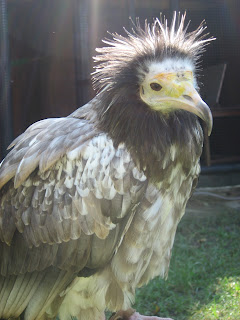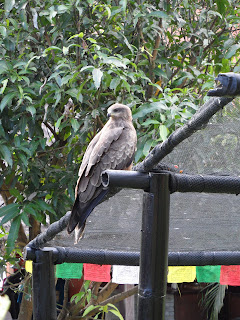As my plane, the first of four, takes off, I take a long look at the mountains surrounding Anchorage. In a few days time, I will be surrounded by mountains again… just slightly larger mountains.
 |
| Buddha statue in the Delhi airport |
In the meantime… a 4 hr flight to Seattle, a one hr layover, a flight to Newark, a 12 hr layover, a 14 hr flight to Delhi, a 10 hr layover, a supposed 2 hour, but turned 4 hr, flight to Kathmandu (2 hours are spent sitting on the tarmac in Delhi before we’re able to take off).
Once in Kathmandu, I’m still not at my final destination. I will be spending the next 5 ½ months in Pokhara, Nepal, working with raptors and paragliders. About 11 years ago, a falconer from England came to Nepal and went paragliding. He saw more birds of prey species during that ½ hour flight than he had during his whole time in England, and decided to stay here to work to protect them. He started Himalayan Raptor Rescue, a rescue and rehabilitation center, the first in Nepal. He then got together with some of his paragliding friends in order to better exercise the birds, having the birds fly up and follow the paragliders soaring in the sky. Soon they began offering this experience to tourists as well, and Parahawking was born. This is the only place in the world you can paraglide with trained birds. The proceeds from the paid tourist flights go to help their rescue work and also to vulture conservation efforts in Asia generally.
But before I head to Pokhara, I have a few hours to spend exploring Kathmandu. Coincidentally, friends from college, Quinlan and Rieko and their son Takeru, are in Nepal on holiday, and we are able to meet up for the afternoon.
 |
| Rieko, Takeru and Quinlan |
We catch up at lunch, then head out to the busy Kathmandu streets to see some of the sights. This is the middle of Dasain, a 15-day-long festival celebrating the goddess Durga, during which numerous animals such as buffalo and goats are sacrificed in her honor. Nepali schools are out of session for these two weeks, and many people are out to purchase food and new clothes for their celebrations. We make our way through the crowds to Durbar Square, a must-see in Kathmandu, filled with temples and religious significance. Everything is getting spruced up in Durga’s honor, and we see workers painting statues and stupas.
 |
| Cows in Durbar Square, Kathmandu |
 |
| Workers freshening paint for Dasain |
We duck into a quiet courtyard for a chance to see Kumari, the living goddess. She appears at a third-story window, decked out in gold and fine clothes, with heavy kohl around her eyes. She stands there looking upon the people below, bestowing her blessings upon them for a few moments each hour. A girl of 3 is chosen for this honor, and she lives the life of a goddess until puberty, at which time she returns to live with her family and another Kumari is chosen. This Kumari is only 5 ½ years old, and as she stands at the window fidgeting with her outfit, it’s hard to imagine her as anything other than a little girl, removed from her life and family and become surrounded by worshippers and ritual. It is a great honor to be chosen as the Kumari, but I wonder if this little girl understands that honor?
 |
| Window of Kumari, the Living Goddess |
We move on to explore other sections of the square. We enter a huge courtyard doubly guarded by a statue of Vishnu and a policeman dressed in camouflage and sporting a bayonet. This courtyard in a few days time will be the site of numerous animal sacrifices to the goddess Kali as a ritual of Dasain. We then visit friends Quinlan and Rieko met on their previous trip to Nepal. We sit and drink chiyaa while Takeru runs and plays in the square with the children. Too soon, it is time to say our goodbyes, as I must meet up with Anita and Jessica, who just arrived at the airport and who I will be working with these next few months. We have a taxi ready to take us the final leg of the trip… to Pokhara.
 |
Sadhu in Durbar Square
|
Traveling around Nepal during Dasain, their largest festival of the year, is not usually recommended. Many Nepalis travel home to spend Dasain with their families, making travel difficult. We leave Kathmandu on crowded roads at 6 pm and don’t arrive in Pokhara until 2 am. I’m exhausted as we make our way to our respective huts, but spend some time unpacking and getting acquainted with my immediate surroundings before I settle down to sleep, excited to see what tomorrow, and the next 5 months will hold.
















































